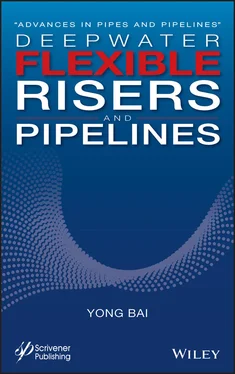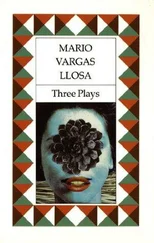11 Chapter 11Figure 11.1 Typical unbonded flexible pipe wall structure [1].Figure 11.2 Global analysis model of unbonded flexible pipe.Figure 11.3 Illustration for node variables: (a) uin; (b)  .Figure 11.4 Hysteretic bending stiffness curve (Péronne et al., 2015).Figure 11.5 Parallelogram hysteresis loop (Zhang et al., 2008).Figure 11.6 Bend stiffener schematic diagram.Figure 11.7 Winkler foundation model.Figure 11.8 Bending hysteresis loop.Figure 11.9 Bend stiffener profile.Figure 11.10 Unbonded flexible riser configuration.Figure 11.11 Effective tension along arc length.Figure 11.12 Curvature along arc length.Figure 11.13 Declination angle along arc length.Figure 11.14 Time history response of top effective tension.Figure 11.15 Time history response of curvatures at bend stiffener’s root end.Figure 11.16 Time history response of curvatures at bend stiffener’s tip end.Figure 11.17 Time history response of maximum curvature in TDZ.Figure 11.18 Bending moment vs. curvature in TDZ.Figure 11.19 Effective tension vs. effective bending stiffness in TDZ.Figure 11.20 Time history response of vertical displacement at static TDP.Figure 11.21 Time history response of effective tension at static TDP.Figure 11.22 Static/dynamic response with different top connection conditions.Figure 11.23 Static/dynamic response with different bending behaviors.Figure 11.24 Static/dynamic response with different top angles.
.Figure 11.4 Hysteretic bending stiffness curve (Péronne et al., 2015).Figure 11.5 Parallelogram hysteresis loop (Zhang et al., 2008).Figure 11.6 Bend stiffener schematic diagram.Figure 11.7 Winkler foundation model.Figure 11.8 Bending hysteresis loop.Figure 11.9 Bend stiffener profile.Figure 11.10 Unbonded flexible riser configuration.Figure 11.11 Effective tension along arc length.Figure 11.12 Curvature along arc length.Figure 11.13 Declination angle along arc length.Figure 11.14 Time history response of top effective tension.Figure 11.15 Time history response of curvatures at bend stiffener’s root end.Figure 11.16 Time history response of curvatures at bend stiffener’s tip end.Figure 11.17 Time history response of maximum curvature in TDZ.Figure 11.18 Bending moment vs. curvature in TDZ.Figure 11.19 Effective tension vs. effective bending stiffness in TDZ.Figure 11.20 Time history response of vertical displacement at static TDP.Figure 11.21 Time history response of effective tension at static TDP.Figure 11.22 Static/dynamic response with different top connection conditions.Figure 11.23 Static/dynamic response with different bending behaviors.Figure 11.24 Static/dynamic response with different top angles.
12 Chapter 12Figure 12.1 The constitution of the towed system.Figure 12.2 Plan view of circle maneuver in towed system.Figure 12.3 Curves of vehicle depth in reference [8].Figure 12.4 Curves of vehicle depth of my simulation model in OrcaFlex.Figure 12.5 The configuration of the towed cable of reference [8] in OrcaFlex.Figure 12.6 Plan view of circle maneuver.Figure 12.7 Depth variation of the towed body.Figure 12.8 Tension variation of the towed end.Figure 12.9 Depth variation of the towed body with the change of the diameter of...Figure 12.10 Maximum tension variation of the towed body with the change of the ...Figure 12.11 Maximum tension variation of Ct (Cn = 1.44).Figure 12.12 Maximum tension variation of Cn (Ct = 0.015).Figure 12.13 Depth variation of towed body with Ct (Cn = 1.44).Figure 12.14 Depth variation of towed body with Cn (Ct = 0.015).Figure 12.15 Distribution of tension along the length direction of the 300-m cab...Figure 12.16 Distribution of tension along the length direction of the 300-m cab...
13 Chapter 13Figure 13.1 Load analysis of pipeline.Figure 13.2 Schematic diagram of lumped mass method.Figure 13.3 Schematic diagram of contact relationship for cable-cable.Figure 13.4 Schematic diagram of umbilical cable.Figure 13.5 Schematic diagram of the model.Figure 13.6 The distribution of the clashing force for interference.Figure 13.7 The distribution of the effective tension under interference.Figure 13.8 The distribution of the curvature of the umbilical cable under inter...Figure 13.9 The distribution of standard deviation of the curvature of the umbil...Figure 13.10 The distribution of the bending moment of the umbilical cable under...Figure 13.11 The distribution of the curvature and bending behavior of the riser...
14 Chapter 14Figure 14.1 Bending stiffener and bellmouth.Figure 14.2 Global configuration of flexible pipe.Figure 14.3 Load model of flexible pipe.Figure 14.4 Cross section of helical strip.Figure 14.5 Bending hysteresis model of flexible pipe.Figure 14.6 S-N curve for high strength steel.Figure 14.7 Comparison between Goodman’s and Gerber’s theory.Figure 14.8 Schematic of bending stiffener.Figure 14.9 Results of global analysis.Figure 14.10 Time history response of pipe tension.Figure 14.11 Time history response of pipe bending curvature.Figure 14.12 Time history response of stress of helical strip at top point.Figure 14.13 Results of global analysis.
15 Chapter 15Figure 15.1 Umbilical cross-section (Bjornstad, 2004).Figure 15.2 IPU dynamic cross-section, super duplex flowline (Heggadal, 2004).Figure 15.3 Diagram of deformations during fabrication and installation.
16 Chapter 16Figure 16.1 Schematic of helical geometry.Figure 16.2 Time history of friction stress for increased tension model.Figure 16.3 Stress behavior of STU versus SCR.Figure 16.4 FPSO/STU system layout.Figure 16.5 STU layup.Figure 16.6 Outer tube friction forces.
17 Chapter 17Figure 17.1 Simplified umbilical model with winding angle.
18 Chapter 18Figure 18.1 Example of subsea umbilical cable structure [1].Figure 18.2 Design flowchart of umbilical cable cross-section [2].Figure 18.3 Design flowchart of umbilical cable cross-section [3].
19 Chapter 19Figure 19.1 External pressure testing system.Figure 19.2 Testing specimens after buckling.Figure 19.3 Representative volume unit of reinforced layer.Figure 19.4 Cross-section of FGRFP.Figure 19.5 The flow chart of Matlab program.Figure 19.6 Ovality-external pressure curve of FGRFP by using numerical analysis...Figure 19.7 First buckling mode of FGRFP subjected external pressure.Figure 19.8 The curve of external pressure and node displacement at the top of p...Figure 19.9 The curve of external pressure and node displacement at the waist of...Figure 19.10 Diagrammatic drawing for the imperfection’s location.Figure 19.11 The stress nephogram of FGRFP.Figure 19.12 The stress curve at top and waist of pipe’s cross-section change wi...
20 Chapter 20Figure 20.1 Typical Construction of FGRFP.Figure 20.2 The curves of burst pressure and time.Figure 20.3 FEM of FGRFP.Figure 20.4 Boundary conditions of FGRFP under internal pressure.Figure 20.5 Axial stress distributions of each layer under internal pressure.Figure 20.6 Global and local coordinate systems.Figure 20.7 Axial stress-pressure curve of inner fiber glass reinforced layer (a...Figure 20.8 Axial stress-pressure curve of each layer.Figure 20.9 Effect of winding angle on internal pressure.Figure 20.10 Effect of winding angle on hoop strain and axial strain.Figure 20.11 Effect of D/t ratio on internal pressure.
21 Chapter 21Figure 21.1 Construction of FGRFP.Figure 21.2 Cross-section of FGRFP.Figure 21.3 Tensile test of the specimen in process.Figure 21.4 Stress-strain data of HDPE from tensile test.Figure 21.5 Failure mode of the specimen.Figure 21.6 Tension-extension relation of three specimens.Figure 21.7 Treatment of reinforced layersFigure 21.8 Interaction force between layers.Figure 21.9 Pipe model in FEM.Figure 21.10 Network of fiberglass in FEM.Figure 21.11 Equivalent cross-section.Figure 21.12 Tension-extension relation from three methods.Figure 21.13 Deformation of FGRFP after extension.Figure 21.14 Radius-extension relation (analytical model and FE model).Figure 21.15 Fiberglass stress variation in different layers (FE model).Figure 21.16 Tension-extension relation of each material (analytical model).Figure 21.17 Comparison between pure PE pipe and FGRFP with the same thickness (...Figure 21.18 The unwinding process of fiberglass (FE model).Figure 21.19 Tension-extension relation of each material in different winding an...Figure 21.20 Contribution of each material in different winding angles (analytic...Figure 21.21 Tension-extension relation of each material in different fiberglass...Figure 21.22 Tension-extension relation of each material in different diameter-t...
22 Chapter 22Figure 22.1 Structure of FRFP.Figure 22.2 Stress-strain curve from tensile test.Figure 22.3 The four-point facility.Figure 22.4 Diagrammatic sketch of facility.Figure 22.5 The four-point facility.Figure 22.6 Bending deformation of three specimens.Figure 22.7 Curvature-moment curves of three test specimens.Figure 22.8 Simplification of reinforced layer.Figure 22.9 The FEM model of FRFP.Figure 22.10 Boundary condition of the FEM model.Figure 22.11 Comparison of results from bending test, theoretical method, and nu...Figure 22.12 Stress distribution in FEM simulation.Figure 22.13 Effect of wall-thickness.Figure 22.14 Effect of Δ0.
Читать дальше

 .Figure 11.4 Hysteretic bending stiffness curve (Péronne et al., 2015).Figure 11.5 Parallelogram hysteresis loop (Zhang et al., 2008).Figure 11.6 Bend stiffener schematic diagram.Figure 11.7 Winkler foundation model.Figure 11.8 Bending hysteresis loop.Figure 11.9 Bend stiffener profile.Figure 11.10 Unbonded flexible riser configuration.Figure 11.11 Effective tension along arc length.Figure 11.12 Curvature along arc length.Figure 11.13 Declination angle along arc length.Figure 11.14 Time history response of top effective tension.Figure 11.15 Time history response of curvatures at bend stiffener’s root end.Figure 11.16 Time history response of curvatures at bend stiffener’s tip end.Figure 11.17 Time history response of maximum curvature in TDZ.Figure 11.18 Bending moment vs. curvature in TDZ.Figure 11.19 Effective tension vs. effective bending stiffness in TDZ.Figure 11.20 Time history response of vertical displacement at static TDP.Figure 11.21 Time history response of effective tension at static TDP.Figure 11.22 Static/dynamic response with different top connection conditions.Figure 11.23 Static/dynamic response with different bending behaviors.Figure 11.24 Static/dynamic response with different top angles.
.Figure 11.4 Hysteretic bending stiffness curve (Péronne et al., 2015).Figure 11.5 Parallelogram hysteresis loop (Zhang et al., 2008).Figure 11.6 Bend stiffener schematic diagram.Figure 11.7 Winkler foundation model.Figure 11.8 Bending hysteresis loop.Figure 11.9 Bend stiffener profile.Figure 11.10 Unbonded flexible riser configuration.Figure 11.11 Effective tension along arc length.Figure 11.12 Curvature along arc length.Figure 11.13 Declination angle along arc length.Figure 11.14 Time history response of top effective tension.Figure 11.15 Time history response of curvatures at bend stiffener’s root end.Figure 11.16 Time history response of curvatures at bend stiffener’s tip end.Figure 11.17 Time history response of maximum curvature in TDZ.Figure 11.18 Bending moment vs. curvature in TDZ.Figure 11.19 Effective tension vs. effective bending stiffness in TDZ.Figure 11.20 Time history response of vertical displacement at static TDP.Figure 11.21 Time history response of effective tension at static TDP.Figure 11.22 Static/dynamic response with different top connection conditions.Figure 11.23 Static/dynamic response with different bending behaviors.Figure 11.24 Static/dynamic response with different top angles.










